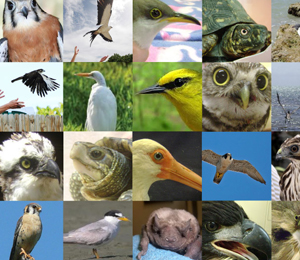Considering how populated the region is, many visitors are surprised at the wildlife that lives in the area in, and around Key West. The marine life is expected, and the temperate climate encourages a number of bird species to make the area their home, but a number of land animals also share the space with people.
When visiting the region, it might be a good idea to expand your definition of the word “wildlife”. Having an open mind will make it easier to view the chickens wandering the streets as delightful, rather than a nuisance. The feral fowl are descendants of the domesticated birds that the Spanish brought with them nearly 200 years ago. When the Spanish settlers cleared out, they neglected to take their poultry with them, leaving the birds to adapt to freedom and flourish. As a good number of the fowl are roosters, a set of earplugs for the light sleeper may keep the morning at bay until the sun rises, because crowing usually begins well before dawn.
Another highlight for many visitors is the polydactyl cats on Ernest Hemmingway’s estate. Hemmingway lived in or visited the Key West estate periodically until 1961, and now the property is maintained as the Ernest Hemingway Home & Museum. The many, many-toed cats are all descendents of Hemingway’s pet cat, Snowball, and are cared for at the Hemingway House. The felines are not supposed to interact with visitors, but the more than 40 cats do not follow the rules, allowing most visitors to get a good look at their six- or seven-toed feet.
For a look at the native species of the Keys, head away from the town. The Key West National Wildlife Refuge is home to many land and water based animals. With more than 2000 acres of land that includes mangrove forests, beaches, salt marshes and coastal areas, visitors can enjoy the habitats of many different island creatures. Most of the areas are only accessible by boat.
Bird-watchers will find a wide variety of nesting and transitory birds living in the Refuge:
•The Magnificent Frigatebird feasts on fish, but lives on land. They have black feathers with a purple iridescence. Males can be identified by the scarlet throat pouch while females have white breast, blue eye ring and a brown band across the wings.
•Ospreys and Bald Eagles are the major airborne predators of Key West. Both are large birds subsisting mainly on fish, but enjoying other types of meals when they can get them.
•The White-crowned pigeon is another strictly land bird that uses the mangrove forests as a breeding ground. Adults are dark grey with a bright white head.
•The Piping Plover nests along the sand and gravel beaches. Their light grey plumage with black banding is excellent camouflage, and they are often unnoticed on the grey-pebbled beaches.
•Terns and other seabirds are found near the water’s edge. The terns prefer large, noisy colonies and many species make no nests, laying their eggs on open sand. Others make floating nests of vegetation in marshy lands and some species build nests in trees.
Even more exciting to spot are the turtles. The Refuge provides protected nesting areas for the endangered Atlantic green, loggerhead and hawksbill turtle.
•The Atlantic green turtle has a flat body covered by a hard carapace shaped like a teardrop. The green turtle is herbivorous and prefers snacking on seagrass in shallow lagoons. These animals face danger from numerous sources including fishing, hunting and pollution.
•The hawksbill is a close cousin to the green and looks quite similar. It’s distinctive features are the sharp beak and saw-like edges of its shell. The shells of these turtles were used in decorations, and hunting them for this purpose has decimated the population. The hawksbill is critically endangered and any nesting areas should be viewed from a distance only.
•The loggerhead is a brownish animal with a reddish shell. Most of their 45 to 65 year lives are spent at sea, coming ashore only to lay eggs. The adults can weigh in at 300 pounds and are safe from most predators due to their size. The eggs and young turtles, however, have many predators. This, and the few number of clutches laid by the females, has contributed to the endangered status of the species.
Key deer are the smallest white-tailed deer in North America, and live in the lower Keys. These tiny, endangered deer are no more than three feet high at the shoulder and likely represent an ancient species that was cut off from the mainland and survived in the predator-free islands. They are herbivorous and spend their time foraging. The Key Deer National Wildlife Refuge is accessible by land and visitors are encouraged to call before arriving to be certain the visitors’ center is open.
In addition to the larger animals, visitors should keep a look out for the dozens of tiny Anole lizards that also call the island their home. Anoles' (or Anolis') color ranges from green to brown depending on the temperature and their mood. If you are squeamish and find their presence unsettling, remember; they eat the other major inhabitants of the islands: Bugs.

